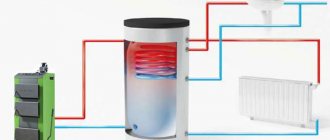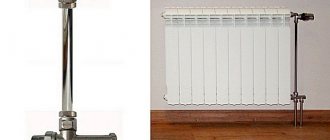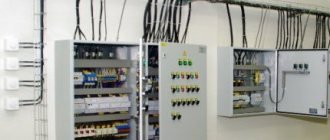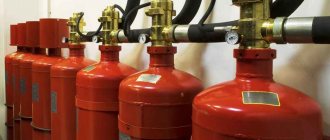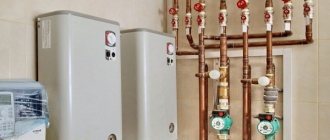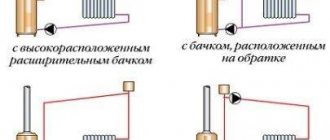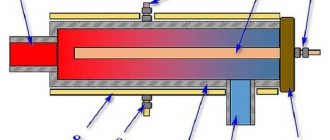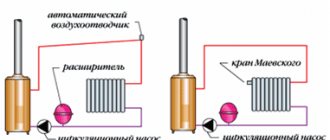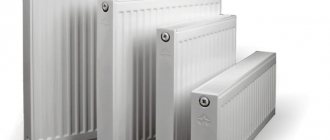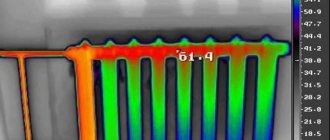Why do you need an air separator?
A device that can cope with the problem of air locks and other contaminants. Called an air separator. If you do not use this device, air and air pockets in the heating system can cause many problems in the coordinated operation of all elements of the system. First of all, the heat transfer of devices begins to decrease.
The absence of a separator can sooner or later lead to premature wear of pump parts, bearings and blades, which will significantly reduce its efficiency.
If the separator does not work or does not work correctly, the inside surface of radiators, boilers and pipes becomes vulnerable to corrosion. The separator is able to completely remove oxygen from the system, thereby de-airing it. One of the disadvantages of the separator is the creation of resistance to the flow of coolant, which directly has a negative impact on the hydraulics of the heating system.
How does the performance of a heating system without a separator deteriorate?
- Small bubbles stick to the walls of the radiator, which stops giving off heat. Heating efficiency is reduced to a minimum.
- The pump that supplies the water wears out, works inefficiently, or stops working altogether.
- Oxygen entering valves, pipes and filters leads to metal destruction.
- The consequence of corrosion is the appearance of rust, which moves along with water masses. Rust accumulations form sludge, which causes the heating system to malfunction.
More recently, the fight against the presence of gas in the system happened like this: the system was always kept under some pressure, which made it possible to protect against oxygen suction. To prevent air penetration, special pipes were used. In places where the greatest accumulation of oxygen occurred, air vents were installed.
Separator design: why air gets into the system
The presence of air in the coolant, whether in an open or closed heating system, poses big problems for all equipment. The heating boiler, pipelines and heating radiators suffer from this. Small bubbles cause great harm to both the pump impeller and shut-off valves, regardless of what material they were made of.
And if the air trapped inside the circuit is not removed outside in a timely manner, it ultimately leads to a decrease in the efficiency of the equipment, increased energy consumption, premature wear and tear of the equipment.
There are several main ways for air to enter the heating system circuit:
- It penetrates along with water, which is added to the systems before the start of the heating season;
- After draining the coolant, when the system is undergoing maintenance or repair of equipment;
- As a result of a chemical reaction when water goes through constant heating and cooling cycles;
- When some elements of the system lose their tightness and through microcracks, ruptures or leaks, air is simply “sucked” inward when the pressure is equalized inside and outside the circuit;
- When the air vent valves are incorrectly adjusted;
As you can see, there are a lot of options and ways to get air into the system. That is why, in order to minimize possible damage from the accumulation of gases in the batteries, pipes and heat exchanger, it is necessary to install a device such as a separator into the system.
Air and sludge separator: cleaning and protecting the heating system
In order for the heating system to function without frustrating failures, there should be no air in it.
An impressive amount of oxygen in the coolant can “give rise” to such phenomena as noisy pumps and batteries that do not heat up. No less a disaster is corrosion - the process of destruction of the metals from which pipes and valves are made. To protect the system from destructive processes, a special device is used - a separator. Its task is to collect oxygen “walking” in the water, then remove it from the coolant.
Negative influence of air on the operation of the heating system
It is difficult for an inexperienced person to believe that ordinary air can become a colossal problem.
But we have to admit: oxygen acts on the condition of the heating system like a slow poison on a living creature. Here are just a few examples of system deterioration caused by air:
- Small air bubbles sticking to the walls of the radiator prevent it from giving off heat. The efficiency of the heating “organism” decreases sharply.
- The pump that supplies water wears out faster.
- Oxygen entering pipes, filters, valves and consumers destroys metal.
- Rust, which appears as a result of corrosion, “wanders” along with the masses of water. When it accumulates, it becomes sludge (dirt) and can lead to system malfunction.
Methods for dealing with air in pipes
Until recently, experts fought the presence of gas in pipes in the following ways:
- made sure that the system was constantly under slight pressure (this trick protects against oxygen being sucked in);
- they used special pipes through the walls of which air cannot penetrate;
- In those areas where it is easiest for oxygen to accumulate, air vents were installed.
Experience has shown that the air vent most effectively copes with the task of eliminating oxygen only when it works in tandem with a separator.
Methods for oxygen penetration into the system
Many people, upset by poor heating in their homes and the frequent accumulation of oxygen in the radiator, rush to blame the specialists who design and install heating equipment for these troubles.
It is easier for an inexperienced person to conclude that the elements of the heating system are not of very high quality and are not airtight, than to understand the true reasons for the appearance of gas in the pipes.
Let's name the main ways air gets into the system:
- Oxygen appears in the pipes in the form of microscopic bubbles located in the water column. When the water gets hot, the air “escaps” from it, turning into free gas. And the more the liquid heats up, the more gas will come out of it.
- Air penetrates through connecting elements (gaskets, air vents).
- After repair work, oxygen can literally “burst” into the heating system.
To be honest, it is unrealistic to completely protect heating equipment from oxygen. Even a long downtime of the system leads to the fact that there is too much air in it, and it has to be vented.
To reliably protect pipes, filters and other components of the heating system, an air separator (separator) is required. The use of this compact device helps solve the problem of “air invasion”. This means you will get rid of the sludge that appears due to oxygen activity.
Air vent and separator are not the same thing
We often hear questions about the difference between an air separator and an air vent.
At first glance, these two devices perform the same task - remove oxygen from heating systems. But the air vent removes gases from the system gradually as they accumulate.
The separator acts more decisively. It quickly separates gases dissolved in water and removes them from the heating system.
If you want all elements of the heating system to work smoothly, it is worth installing an air separator. It is important to choose a compact device that would cope with the responsibilities of removing oxygen from the coolant. Over the past few years, flamcovent separators have become extremely popular.
The effectiveness of these devices is enormous, because their work is based on the principle of fusion. The essence of the method: tiny air bubbles, in contact with the surface of the device, stick to it. In a short period of time, the bubbles combine into large “clouds”. Then they break away from the separator and float up.
The Importance of Pall Rings
If you are thinking about purchasing an air separator, you will probably be curious about how flamcovent separators “fish out” even tiny air bubbles from the flow so quickly and efficiently.
Methods for dealing with air in pipes
Until recently, experts fought the presence of gas in pipes in the following ways:
- made sure that the system was constantly under slight pressure (this trick protects against oxygen being sucked in);
- they used special pipes through the walls of which air cannot penetrate;
- In those areas where it is easiest for oxygen to accumulate, air vents were installed.
Experience has shown that the air vent most effectively copes with the task of eliminating oxygen only when it works in tandem with a separator.
Separators for degassing and sludge removal
Fig.1 Separator
The separators that appeared in recent years in the Russian Federation began to be produced in Europe more than 30 years ago and have become a standard element for degassing and removing sludge from heating and water supply systems. In addition to removing plugs, separators remove microbubbles and sludge particles from the water flow and combine the functions of air vents, filters and deaerators. Separators do not require consumables, energy or maintenance, operate for several decades, and have a simple and reliable design without moving parts.
The universal separator is a metal cylinder with an air vent at the top, a sludge discharge valve at the bottom and a stationary mechanical separating element inside (Fig. 1). An element inside the separator ensures rapid transport of microbubbles to the top and deposition of insoluble particles below as the water flow passes through the separator. The separator's automatic float air vent removes air accumulated at the top, and periodic sludge removal is carried out manually using a ball valve at the bottom of the separator. In both cases, the system does not depressurize. When the system is initially filled with water, large air bubbles are quickly removed using a special valve in the air vent housing. Separators are installed vertically.
Separators from different companies, as a rule, differ in different types of separating elements. In Pneumatex separators (Switzerland), such an element uses a petal spiral (spirals) with a profiled surface made of stainless steel, installed vertically along the axis of the separator (Fig. 1). The mechanisms for extracting gases and solid particles may also be different. As a rule, the gravitational mechanism of particle sedimentation and bubble sublimation is used. To enhance the effect, the flow speed inside the separator is reduced (the cross section is increased), and the flow is laminarized. Some models use a centrifugal effect to spin the flow inside the separator. When using working elements with a large area, the mechanism of sorption of microbubbles on the surface is activated with their further merging into larger bubbles and floating up.
The range of application of separators is quite wide.
For example, Pneumatex industrial separators (standard sizes DN 50 – 600 mm) are capable of processing flows in the range of 5 – 2000 m 3 /h. The housings of industrial separators are made of steel.
Brass separators for small objects (standard sizes DU 20 – 40 mm) process flows up to 5 m 3 /h. All brass separators are assembled from basic elements and can be easily transformed.
Do-it-yourself hydraulic arrow for heating
Since the structure of the device is simple, many people want to make it themselves.
Calculations of the size of a hydraulic arrow for heating begin with the diameter of the pipe, which is suitable for a particular system.
For calculations you will need the following data:
- Boiler power (kW) - W.
- The difference between the flow and return temperatures is ΔT.
By substituting the data, you can use the formula to calculate the minimum internal diameter (D) in mm.
2-3 internal diameters of the device should “fit” between the nozzles.
But not everything is as simple as it seems. To make an arrow yourself, you need welding skills. The services of a hired specialist will cost quite a bit. It is not always easy to find high-quality pipes with straight threads, then you will have to resort to the services of a turner. As a result, the total cost of materials, labor and time may even exceed the cost of purchasing a ready-made factory device.
There is one more point in which homemade products are inferior to factory-made analogues. Since they do not have a thermal protective casing, the separator radiates heat where it is not intended by the owner.
About air traps in the heating system
The system may have a hump in the supply line. The bubble will easily enter this hump, but it will be extremely difficult for it to come out. Sometimes it's completely impossible. Here we have the most difficult case. Depending on the steepness of the hump, we may never remove this air from the system at all. Only if you cut the pipe at the very top and cut in a valve to bleed air.
There are complex devices in the heating system from which air cannot escape in principle. This is, for example, a radiator. If the radiator has an inlet and outlet on one side (for example, on the left), and the second side (right) has plugs at the top and bottom, then this radiator will collect air on the right and it will never leave there. And we won’t be able to get this bubble out of there with any manipulation. Another popular case is when water enters the radiator from the bottom and exits from the bottom. Then a bubble may form at the top of the radiator and you cannot expel it through the bottom of the radiator either.
Radiator - air trap
Separators with magnetic traps
Pneumatex separators with magnetic traps (DN 20 – DN 400 mm) trap insoluble iron impurities in water much more effectively than conventional separators. The rod(s) with a powerful magnet are inserted from below from the outside into the separator sleeve and removed before the operation of washing out the sludge without violating the tightness of the system. The magnetic rod is separated from the water by the walls of the sleeve and does not require cleaning or protection from corrosion. The sleeve is made of non-magnetic material, so the magnetic particles quickly settle down and then the sludge is washed away through the valve. For effective flushing, the valve is offset from the center (creating a vortex effect). Separators with magnetic traps also contain conventional separating elements and have all the degassing and non-magnetic particle removal properties of conventional separator models.
For what purposes are sludge separators and deaerator separators built into the heating system of a house?
There are quite a lot of heating malfunctions caused by saturation of the coolant with air and sludge. But most often the visible signs of a violation are:
- Violation of the heat transfer of the heating battery - this can be airing or the creation of an air lock or the settling of air bubbles on the walls of the radiator. Such an air gap interferes with normal heat exchange and reduces the efficiency of the device;
- Small bubbles, oddly enough, have a very negative effect on the operation of pumping equipment. It’s not difficult to imagine how air interferes with the pump’s operation. The pump impeller is constantly in the liquid, rotating, creating a flow that is further pushed through the pipes. If the liquid is homogeneous, then the electric motor operates stably with a constant load. If there are a large number of bubbles in the liquid, then the density will be non-uniform, the pump will operate jerkily, which will lead to wear of the electric motor.
- The bubbles do not contain atmospheric air; most of them are filled with oxygen. And if a person cannot do without it, then rubber products, plastics and seals are actively destroyed by it. Oxygen also has a detrimental effect on metal - during the reaction, a corrosion zone is formed, which can lead to a violation of the tightness of the system;
- The water supplied to the heating system is not always treated and deferrized. Often the system is filled from local sources, where the water may contain both large insoluble particles, such as inclusions of clay or sand, and soluble salts. Often it is dissolved salts that form tiny particles of calcium and iron when heated. It is this debris that causes clogging of batteries and pipelines.
A separator installed in the system allows you to separate these inclusions from the liquid and thereby ensure trouble-free operation of the equipment.
Design, purpose and principle of operation of the hydraulic arrow
The hydraulic arrow for heating consists of a bronze or steel body with two pipes for connecting to the boiler circuit (supply pipe + return pipe), as well as several pipes (usually 2) for connecting the heat consumer circuits. An automatic air vent is mounted in the upper part of the hydraulic separator through a ball valve or shut-off valve. at the bottom there is a drainage tap. A special mesh is often installed inside the housing of factory hydraulic arrows, which allows small air bubbles to be directed into the air vent.
Design of the Valtec VT model. VAR 00.
The hydraulic arrow for heating performs the following functions:
- Maintaining the hydraulic balance of the system. Turning on/off one of the circuits does not affect the hydraulic characteristics of the remaining circuits;
- Ensuring the safety of cast iron boiler heat exchangers. The use of a hydraulic arrow allows you to protect cast iron heat exchangers from sudden temperature changes (for example, during repair work, when the circulation pump is turned off, or when the boiler is turned on for the first time). As is known, a sharp change in coolant temperature negatively affects cast iron heat exchangers;
- Air vent. The hydraulic arrow for heating performs the functions of removing air from the heating system. To do this, in the upper part of the device there is a pipe for installing an automatic air vent;
- Filling or draining coolant. Most of both factory-made and self-made hydraulic switches are equipped with drain valves, through which it is possible to fill or drain coolant from the system;
- Cleaning the system from mechanical contaminants. The low flow rate of the coolant in the hydraulic separator makes it an ideal device for collecting various mechanical contaminants (scale, scale, rust, sand and other sludge). Solid particles circulating through the heating system gradually accumulate in the lower part of the device, after which they can be removed through the drain valve. Some models of hydraulic arrows can be additionally equipped with magnetic catchers that attract metal particles.
Why should you use a hydraulic boom?
Section of the heating system with a hydraulic arrow.
From a different angle.
In heating systems where there are two or more heating circuits (radiators, water-heated baseboards, heated floors, hot water supply), as a rule, the circuits are connected to each other by a common manifold. At the same time, the presence of a common collector can lead to the following problems:
- The circulation pumps of each circuit influence each other (especially if the pumps differ in power). To overcome the effects of a more powerful pump, the low-power pump must operate at its limit, consuming more electricity than required under “normal” conditions. At the same time, working at the limit of their capabilities, pumps fail earlier. In addition, under such conditions the pump cannot always provide the required performance;
- Even if the circulation pump of one of the boilers was turned off, its radiators will still heat up (under the influence of the other pumps, coolant circulation in the turned off circuit will continue);
- Difficulties in calculating pump power for both the boiler and heating circuits. The boiler pump power should be selected taking into account the total power of the heat consumer pumps.
All of the above problems can be solved by a hydraulic arrow.
Side view of the arrow.
Note! In a hydraulic separator, the speed of movement of the coolant decreases sharply (by about 9 times), this is due to the fact that upon entering the separator, the diameter of the flow increases several times (usually 3 times). Thanks to this, pressure drops in the system are eliminated.
Installation recommendations
Requirements for installing a separator in a heating system.
An air and sludge separator is installed in the supply immediately after the boiler. As noted above, the largest number of bubbles are released from water when it is heated in a boiler. If they are not removed immediately, they will dissolve in the cooling water.
The device is installed in front of the circulation pump. This prevents air bubbles from entering the pump housing, which in turn reduces wear on pump parts.
How does an air separator for heating work (video)
The air separator is designed to prevent clogging of heating systems. If cleaning is not carried out systematically, the system will begin to malfunction and the pipes will be cold. The separator is designed in such a way that it collects air bubbles and instantly removes them from the system. The sludge separator is excellent at removing sediment that clogs the system. It is important to choose a high-quality device that will work efficiently and without failures.
